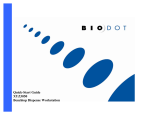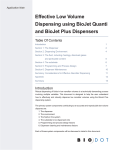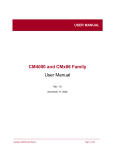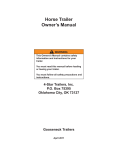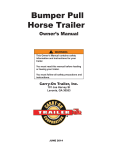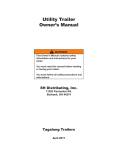Download Quick-Start Guide v1.2 CM4000 Guillotine Cutting
Transcript
Quick-Start Guide v1.2 CM4000 Guillotine Cutting System Quick Start Guide To CM4000 INTRODUCTION The CM4000 is designed to cut lengths of material into strips for use in rapid diagnostic tests. It is a fully automatic card cutter with programmable cut length to meet the specifications of each user. It has a hold down bar to ensure quality cut precision and blades that are easy to remove and clean without the need for calibration. Various blade angles are also available to optimize cuts. REQUIREMENTS FOR SETUP You will need a flat surface that will support the system’s weight and dimensions. The system weighs approximately 53 lbs and requires a surface space of 17in (length) by 14in (height) by 10in (depth). You will also need a power source and, if you purchased the anti-static option, a clean, dry, filtered air source. INSTRUCTIONS FOR UNPACKING Your system will arrive in one large box, within which you will find the cutter system, a Hand Held Terminal, a power cord, and any optional components you ordered (for example, an anti-static blowing unit). The system will be wrapped in silver plastic. 1. Unpacking Your System a. Remove the cutter from the box. **Warning: When lifting the cutter from the box, lift it from the bottom. Lifting it by the blade roller housing, dust cover, or other external parts may misalign and damage the unit. b. Place the cutter on a flat, level surface that will support its weight and size and remove the shrink wrap. c. Remove the power cord, Hand Held Terminal, and other accessory components. On the next page, you will find labeled images of the CM4000 system which you will find useful to review and refer back to as you go through this guide. www.biodot.com Page 1 of 10 www.biodot.com Page 2 of 10 SETTING UP YOUR SYSTEM 1. Verify that the main power switch, located on the back of the unit, is off. 2. Remove the button head screw from the gearbox breather hole in the rear panel. **Warning: Do not tip the cutter once this screw has been removed or the oil in the gearbox will spill. 3. Plug the supplied spiral cord into the hand-held terminal. Connect the other end of the cable to the hand-held terminal plug on the side of the cutter (labeled “Terminal”). Note: The ports labeled “Network 1, 2” are for factory use only. 4. Plug the power cord in to a grounded power source. Plug the other end of the cable in to the power cord receptacle on the side of the cutter. 5. Turn the power on. **Warning: Cutting Blades are very sharp! Operate only when cover is down. Never place hands or instruments near blades unless powered off. Note: Make sure that the protection/dust cover is in the closed position. 6. Press Enter on your hand-held terminal to display the Main Menu. 7. Place the material (master strip) that you want to cut between the material guide rails. 8. Adjust the width of the guides as necessary using the guide thumbscrews. Note: Custom applications may have a stationary material guide system. 9. Adjust the position of the upper material rollers to match the thickness of the material to be cut using the thumbscrews on top of the blade/roller housing. 10. Use the left and right arrow keys on the hand-held terminal to move the material back and forth. 11. Feed material through the blades until it shows slightly beyond the front cutting surface of the lower blade. a. Use the Park/Home key to toggle the blade position so that the material is trimmed flush with the lower blade. This ensures that the first piece of the cutting cycle is of the desired length. 12. If the length of your cut material exceeds 4in, install the supplied material feed output station in front of the cutting blade. www.biodot.com Page 3 of 10 The CM4000 (standard configuration) is now ready to be programmed for a cutting job. If you purchased accessory components, please move on to the next section for installation instructions. If you did not, please skip to the Section entitled “Operating Your Cutter.” INSTALLATION OF OPTIONAL COMPONENTS Anti-static Blower Option The Anti-Static Blower Option reduces static charge build up. The airflow for the unit also assists in moving cut material down the exit chute. The Anti-Static Bar is pre-assembled on your cutting module (if added to the standard model). The air compressor is not included. Please proceed with the following directions to activate the necessary air on your Anti-Static Option. 1. Attach one end of the supplied airline to the hose barb on the side of the Anti-Static Bar on the top of the cutter. 2. Attach the other end of the airline to a source of compressed air. If a small compressor is used it should be capable of delivering approximately 1 SCFM air flow. a. Use an airflow control to adjust upward or downward to improve performance. If factory air is used instead, an airflow control will be required to limit flow. 3. Plug in the electrical connector on the air compressor to an electrical outlet. 4. Turn the air compressor power switch to "on." Note: To turn compressor off, turn the switch to "off" or unplug the cable from the electrical outlet. Note: The Anti-Static Option will be activated when the Anti-Static power supply is turned on. The Anti-Static Option will turn off if the Cutter cover is lifted or the Cutter power switch is turned off. www.biodot.com Page 4 of 10 Leading Edge / Target Index Sensor Options The Leading Edge Sensor or Target Index Sensor Options on the Cutting Module CM4000 are already factory pre-assembled on your equipment if you have ordered them. No assembly is required. Reel Feed Option The Reel Feed Option is pre-assembled on your cutting module if ordered. To place your roll material onto the magazine feed option: 1. Take off the front side of the acrylic reel (front-side Reel Flange) by opening the black flange lever Insert and fit the roll material onto the inner hub of the acrylic reel. 2. Re-install the side of the acrylic reel onto the reelassembly. 3. Tighten the reel by using the black flange lever and the tension adjustment knob. Strip Guide with Bottle Holder Option The Strip Guide with Bottle Holder Option is already factory pre-assembled on your equipment (if added to the standard model). No assembly is required. Note: The Strip Guide with Bottle Holder assembly is installed such that the system must be set up to allow the bottle holder to hang over the edge of a flat surface. www.biodot.com Page 5 of 10 OPERATING YOUR CUTTER VIA HAND HELD TERMINAL Operation of the CM4000 with useful figures is detailed in the chapter 3 of the Manual. The following is a brief summary. 1. Introduction to the Hand-Held Terminal a. Refer to the image below for a labeled image of the HHT (Hand-Held Terminal): www.biodot.com Page 6 of 10 Following is a list of the HHT’s (Hand-Held Terminal’s) keys and what they do: Go Key Abort Key Pause Key Runs active programs.. Terminates a running program Pauses a running program and gives you the choice to either abort the program (by pressing Abort) or continue it (by pressing Go). Park/Home Used to alternately raise/lower the blade, which allows the user to perform a cut manually. When the cutter is turned on, the blade will move to and rest in the raised position. Pressing the Park/Home key once will cause the blade to move to the lowered position. Pressing it a second time will raise the blade. Up Navigates the HHT menus. Down Navigates the HHT menus. Esc Takes you out of one screen to the previous screen. Enter Used to select a menu item or when entering data (to enter a typed value into a data field). Numeric Keys Used for data entry. 2. Blade Control: Adjusting the Cutting Rate: Note: Blade speed control is available on standard (nonpneumatic) cutting modules only. a. Turn the speed control clockwise to increase the cutting rate; turn it counterclockwise to reduce the cutting rate. 3. Reviewing a Sample Program: a. From the Main Menu, go to Programs. Press Enter. b. Select a Demo program by pressing Enter to put a check next to it. c. Press Esc to return to the Main Menu. d. Go to the Program menu. e. Go to the Edit Program sub-menu. f. Find the Demo Program you selected and open it by pressing Enter. Note: You will not be editing the pattern at this time; the purpose of entering the Demo program through the Edit menu item www.biodot.com Page 7 of 10 is to review the program’s parameters to acquaint yourself with how a program is written and what each value does to control the operation of the system. 4. Running a Sample Program: Starting a Cutting Cycle: a. From the Main Menu, go to the Programs sub-menu. b. Go to the “Select Program” option. c. Select a program to run and put a check next to it by pressing Enter. i. You should still have a program selected from Step 3 above. d. Press Go. Note: To stop the program at any time, press Abort. 5. Calibrating Cut Length: Note: The unit has been calibrated for 5mm cut lengths, unless otherwise specified. a. Cut and measure a length of material by running a program. b. On the HHT, select the Calibrate menu item. c. On the Calibrate sub-menu, select Length Calibrate. d. Key in your desired length and press enter. e. Key in the actual length and press enter. For example: Set the program cut length to 5mm and cut 2 pieces. At the “Desired Length” prompt enter 5mm, measure the second piece and enter this value at the “Actual Length” prompt. Run the test again; verify that the new cut piece is equal to the program “Length.” f. Once the desired length is obtained, save the configuration data by doing the following: i. Return to the Main Menu (by pressing Esc). ii. Go to the Data Storage sub-menu. iii. Select “Save Data”. Note: If you purchased leading edge or target sensor options, please see the pg.33 of the User Manual for instructions on calibration. 6. Creating a New Program: a. To create a new program, first enter the name of the program by doing the following: i. Go to the “Programs” menu. www.biodot.com Page 8 of 10 ii. Select “Create Program”. iii. Type in a program name, and press Enter. iv. Immediately save this name by doing the following: 1. Press the Esc key to return to the Main Menu. 2. Go to the “Data Storage” menu. 3. Select “Save Progs/Config”. b. You can now make changes to the default parameters of the program by doing the following: i. Go to the “Programs” menu. ii. Select “Edit Program”. iii. Select the program you just created and press Enter. c. Make your desired changes. d. Save the data you entered by doing the following: i. Press Exc to return to the Main Menu. ii. Go to the “Data Storage” menu. iii. Select “Save Progs/Config”. TROUBLESHOOTING PROBLEM Unit does not power up (Display not lit, no menu displayed) The motor does not move when a cycle has been started, and a “BLADE TIMEOUT” error is POSSIBLE SOLUTIONS − Ensure that power switch is in ON position. − Ensure that the unit is plugged into an approved earth grounded power − source. − Check fuses; replace if necessary. Use 3AG 7A 313 SLO-BLO fuses BioDot − part number 1017-0015. − Check that the protective cover is closed. − Check for obstructions in the cutter mechanism. www.biodot.com Page 9 of 10 signaled − Non-pneumatic Cutters: The blade is moving too slow for the programmed blade time-out period. Increase the blade speed via the blade speed control* and/or increase the value for the blade time-out (see Ä CONFIGURATION Menu section in Chapter Three – Creation of Cutting Programs). The blade moves, but a “BLADE TIMEOUT” error is signaled * − Pneumatic Cutters: Check that the compressed air supply is connected. Increase the airflow to the unit, should now set to about 80 PSIG. FOR MORE INFORMATION This Quick-Start Guide should get you started using your CM4000. It is not intended to be comprehensive, however. It is therefore recommended that you review your User Manual for complete information on setup, operation, and maintenance of your system. If you encounter a problem that is not addressed by your User Manual or if you are missing any component of your order, please contact us at (949) 440-3685 or email us at [email protected]. www.biodot.com Page 10 of 10











